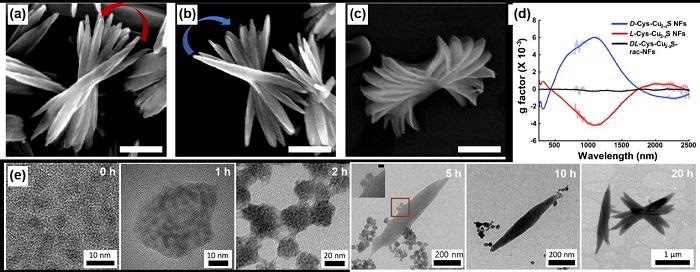A team of researchers successfully transferred chirality from the molecular scale to microscale to expand material platforms and applications. The optical activity from this innovative chiral material falls in the short-wave infrared region.
 Self-assembly of Cu2S NPs to NFs and chiroptical properties of NFs. (a-c) Scanning electron microscopy (SEM) images of NFs assembled from (a) L-Cys-, (b) D-Cys-, and (c) DL-Cys-Cu2S NPs. (d) Circular Dichroism (CD) spectra of NFs shown in (a-c), which shows chiroptical activity in the UV-SWIR region. (e) Transmission electron microscopy (TEM) images of different stages during NFs formation, NPs (0 hours) assembled into NFs (20 hours) through supraparticles (1 hour, 2 hours) and nanoleaves (5 hours, 10 hours). Image Credit: KAIST.
Self-assembly of Cu2S NPs to NFs and chiroptical properties of NFs. (a-c) Scanning electron microscopy (SEM) images of NFs assembled from (a) L-Cys-, (b) D-Cys-, and (c) DL-Cys-Cu2S NPs. (d) Circular Dichroism (CD) spectra of NFs shown in (a-c), which shows chiroptical activity in the UV-SWIR region. (e) Transmission electron microscopy (TEM) images of different stages during NFs formation, NPs (0 hours) assembled into NFs (20 hours) through supraparticles (1 hour, 2 hours) and nanoleaves (5 hours, 10 hours). Image Credit: KAIST.
This platform could act as a robust approach for hierarchical transfer of chirality through self-assembly, producing wider optical activity and offering immense applications, such as bio, telecommunication and imaging technique. This is the first-ever witness of such a broad window of chiroptical activity from nanomaterials.
We synthesized chiral copper sulfides using cysteine, as the stabilizer, and transferring the chirality from molecular to the microscale through self-assembly.
Jihyeon Yeom, Research Lead and Professor, Department of Materials Science and Engineering, KAIST
The findings of the study were published on September 14th, 2021, in ACS Nano.
Chiral nanomaterials offer a rich platform for multipurpose applications. Adjusting the wavelength of polarization rotation maxima in the wide range is a potential candidate for infrared neural stimulation, nanothermometry and imaging. But most of the chiral nanomaterials developed earlier showed the optical activity in a comparatively shorter wavelength range, not in short-wave infrared.
Achieving chiroptical activity in the short-wave infrared region requires the materials to be in sub-micrometer dimensions, compatible with the wavelength of short-wave infrared region light for powerful light-matter interaction. Moreover, they should exhibit the optical property of short-wave infrared region absorption while forming a chiral structure.
Professor Yeom and his colleagues triggered the self-assembly of the chiral nanoparticles by regulating the attraction and repulsion forces between the building block nanoparticles. This process lead to the transfer of molecular chirality of cysteine to the nanoscale chirality of nanoparticles, which was eventually transferred to the micrometer scale chirality of nanoflowers with dimensions of 1.5-2.2 μm formed by the self-assembly.
We will work to expand the wavelength range of chiroptical activity to the short-wave infrared region, thus reshaping our daily lives in the form of a bio-barcode that can store vast amount of information under the skin.
Jihyeon Yeom, Research Lead and Professor, Department of Materials Science and Engineering, KAIST
This research was financially supported by the Ministry of Science and ICT, the Ministry of Health and Welfare, the Ministry of Food and Drug Safety, the National Research Foundation of Korea, the KAIST URP Program, the KAIST Creative Challenging Research Program, Samsung, and POSCO Science Fellowship.
Journal Reference:
Park, K. H., et al. (2021) Broad Chiroptical Activity from Ultraviolet to Short-Wave Infrared by Chirality Transfer from Molecular to Micrometer Scale. ACS Nano. doi.org/10.1021/acsnano.1c05888.